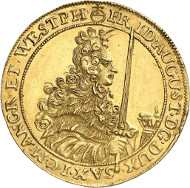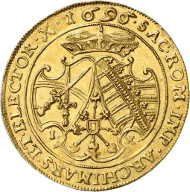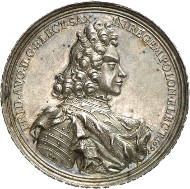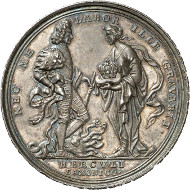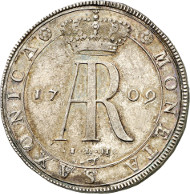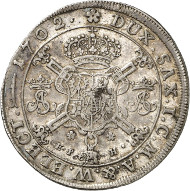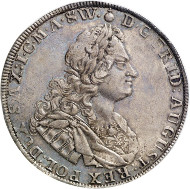In 1694, Frederick August I ascended to the throne after the death of his brother George IV who had reigned for three years only. August the Strong, as he loved to call himself, was perfectly prepared for his task. He had been trained by excellent teachers, had travelled around Europe for three years and had even deserved acknowledgement as military commander.
Before the election as Polish King: Frederick August I, 1694-1733. 3 ducats 1696, Dresden. Made with the dies of the 1/4 reichsthaler. Kahnt 26. From the upcoming Künker auction 258 on January 29, 2015. The piece has been estimated at 35,000 euros.
Frederick August was highly gifted and incredibly ambitious. “Little” Saxony was not enough for him. He wanted to join the game of international politics. Only three years after his accession to the throne a splendid opportunity occurred to him: on July 17, 1696, the Polish King died. Poland didn’t follow the principle of primogeniture. It was an elective monarchy. So the roughly 100,000 Polish citizens entitled to vote had to choose between 10 candidates, including the Elector of Saxony.
The election took place against the backdrop of the War of the Spanish Succession that affected the whole of Europe. One party was the French who used enormous bribes in order to get their candidate, Prince of Conti, elected on June 26 with four out of five votes. The same election was conducted a second time the following day. Winner, with 50% of the votes, was August the Strong, candidate of Russia and the House of Hapsburg. He had not only converted to Catholicism but had likewise resorted to bribery. On his order, his court Jew, Issachar Lehmann, had sold or given in pawn all Saxon exclaves and thus liquidized millions of gulden which found their way into the pockets of the voters. Hence, there were two elected kings. August, however, had the stronger army on site: a marvelous argument in the time of absolutism. Conti had only managed to get to Danzig when August was crowned Polish King, August II, in Cracow on September 15.
The coronation as Polish King: Frederick August I, 1694-1733. Medal from 1697 of G. Hautsch on the coronation as King of Poland. Merseb. Coll. 1390. Ex Horn Collection. From the upcoming Künker auction 258 on January 29, 2015. The piece has been estimated at 1,000 euros.
A gorgeous medal created by Georg Hautsch commemorates this coronation. August the Strong is depicted as Hercules placing his foot on the multi-headed Hydra. In Baroque times, Hercules was considered the embodiment of a perfect ruler who, when facing the crossroad, choses the narrow path of virtue over the broad one of vice. According to common belief, that was how the demi-god successfully overcame all obstacles. This depiction gives us a good idea as to how August the Strong, who is taking the crown from the hand of Polonia here, saw himself: as an untiring worker who, thanks to his diligence, was to win his rule the greatest fame possible.
The Polish, though, begged to differ. Poland was an agrarian state with a population of 12 million who were ruled by approximately 100,000 men of the lesser nobility. They did not get anything out of the German efficiency with which Frederick August intended to modernize their country. While the Polish magnates were proud about their Republic, their new king tried to strengthen the central power at the expense of the nobility. Conflict was inevitable.
Wrong decisions in the foreign policy added to this. August’s lifestyle, characterized by large quantities of alcohol in combination with a great number of women, perfectly chimed in with the one of Peter the Great. Unfortunately, the latter was sovereign of Russia, hence the natural enemy of a powerful Poland. Despite this, the rulers liked each other and made plans together. They wanted to wrench some European possessions from Sweden where a young and inexperienced king had just ascended to the throne. Nobody anticipated that Charles XII was a military prodigy who needed a minimum of time to get both Russia and Poland in hot water after which he gave the Polish an ultimatum: if they did not depose King August Charles would inflict war on Poland.
After the deposition as Polish King: Frederick August I, 1694-1733. Reichsthaler 1709, Dresden. Schnee 1005. Ex Horn Collection. From the upcoming Künker auction 258 on January 29, 2015. The piece has been estimated at 6,000 euros.
Many Polish noblemen though that an imposition and affiliated themselves to the king in a way they would never have imagined. A small minority, though, elected Stanislaw Leszczynski new king on July 12, 1704. With that, the ideal prerequisites had been created for a total, a free-for-all war. Not a single city in Poland was spared the subsequent pillages before the victor Charles XII enforced the Treaty of Altranstädt on September 24, 1706: August was forced to renounce his claims to the throne while Stanislaw Leszczynski was acknowledged king and the coalition with Russia terminated.
A reichsthaler from 1709 shows how August coped with this defeat in terms of propaganda. He still called himself REX, King, both in the obverse legend and in the monogram on the reverse. Albeit, what he was king of, his coinage did not say.
After the restitution as Polish King: POLAND. Frederick August I, 1694-1733. Reichsthaler 1702, Leipzig. Kopicki 2017. Ex Horn Collection. From the upcoming Künker auction 258 on January 29, 2015. The piece has been estimated at 2,500 euros.
Things turned around in Poland already that year. Leszczynski had only managed to remain on the throne thanks to the support of the Swedish. The series of victories of Charles XII, however, came to an end with the defeat in the Battle at Poltava. He fled to the Turks, and Leszczynski had no other option than to go into exile. August returned and renewed the alliance with Peter. The rulers, though, were no longer partners on an equal footing. The Russian Tsar insisted on keeping Poland weak. The “Silent Sejm” from 1717 saw no discussion but a fixation of the 1648 situation, which, however, was no longer adapted to meet the changed requirements. Problems were bound to occur. Nevertheless, for its dictate Russia even pocketed Livonia and Courland.
After the restitution as Polish King: Frederick August I, 1694-1733. Reichsthaler 1728, Dresden. Schnee 1015. From the upcoming Künker auction 258 on January 29, 2015. The piece has been estimated at 4,000 euros.
The Polish became demoralized as a result. Polish historiography refers to the following time as “dark period”. There was no religious tolerance. The economy collapsed due to the devastations caused by the war, and education is said to have not even reached the level of Medieval times.
Hence, it was no victory when August the Strong made sure that his son would succeed him to the Polish throne. In fact, it was more the beginning of the end. Poland had become the pawn in the hands of the great powers, and was to be divided for the first time in 1772, when a Polish king did not consult Russia’s interests properly.
If you are interested in the coins featured in this article, you can go directly to the Künker Berlin-sale, where they are on offer.
Of course, CoinsWeekly is also offering an auction preview of this sale.




